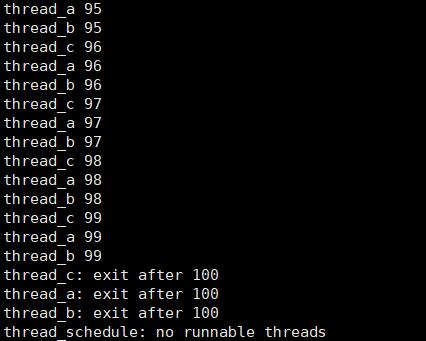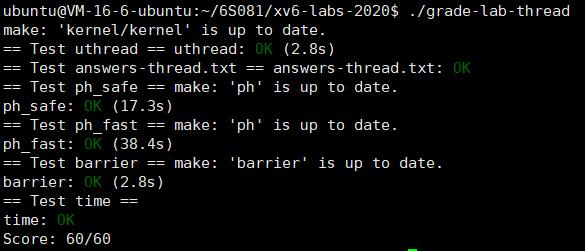# MIT6.s081-2020 Lab7 Multithreading
本实验将使您熟悉多线程。您将在用户级线程包中实现线程之间的切换,使用多个线程来加速程序,并实现屏障。
# 准备
git fetch
git checkout thread
make clean
2
3
# Uthread: switching between threads
引言
在本节中,您将为用户级线程系统设计上下文切换机制,即创建线程并保存/恢复寄存器以在线程之间切换。
实现
本节内容需要在user/uthread.c中添加thread_create()和 thread_schedule()的具体实现,在user/uthread_switch.S中实现thread_switch来切换上下文资源。上述内容可以参考kernel/switch.S和kernel/proc.c
user/uthread_switch.S
thread_switch:
/* YOUR CODE HERE */
sd ra, 0(a0)
sd sp, 8(a0)
sd s0, 16(a0)
sd s1, 24(a0)
sd s2, 32(a0)
sd s3, 40(a0)
sd s4, 48(a0)
sd s5, 56(a0)
sd s6, 64(a0)
sd s7, 72(a0)
sd s8, 80(a0)
sd s9, 88(a0)
sd s10, 96(a0)
sd s11, 104(a0)
ld ra, 0(a1)
ld sp, 8(a1)
ld s0, 16(a1)
ld s1, 24(a1)
ld s2, 32(a1)
ld s3, 40(a1)
ld s4, 48(a1)
ld s5, 56(a1)
ld s6, 64(a1)
ld s7, 72(a1)
ld s8, 80(a1)
ld s9, 88(a1)
ld s10, 96(a1)
ld s11, 104(a1)
ret /* return to ra */
2
3
4
5
6
7
8
9
10
11
12
13
14
15
16
17
18
19
20
21
22
23
24
25
26
27
28
29
30
31
32
33
为了实现上下文寄存器的保存与回复,我们需要定义context 成员变量保存上下文,即
user/uthread.c
struct context {
uint64 ra;
uint64 sp;
// callee-saved
uint64 s0;
uint64 s1;
uint64 s2;
uint64 s3;
uint64 s4;
uint64 s5;
uint64 s6;
uint64 s7;
uint64 s8;
uint64 s9;
uint64 s10;
uint64 s11;
};
struct thread {
char stack[STACK_SIZE]; /* the thread's stack */
int state; /* FREE, RUNNING, RUNNABLE */
struct context context;
};
void
thread_schedule(void)
{
struct thread *t, *next_thread;
//...
if (current_thread != next_thread) { /* switch threads? */
next_thread->state = RUNNING;
t = current_thread;
current_thread = next_thread;
/* YOUR CODE HERE
* Invoke thread_switch to switch from t to next_thread:
* thread_switch(??, ??);
*/
thread_switch((uint64)&t->context,(uint64)¤t_thread->context);
} else
next_thread = 0;
}
void
thread_create(void (*func)())
{
struct thread *t;
//...
// YOUR CODE HERE
t->context.ra = (uint64)func;
t->context.sp = (uint64)(&t->stack[STACK_SIZE]);
}
2
3
4
5
6
7
8
9
10
11
12
13
14
15
16
17
18
19
20
21
22
23
24
25
26
27
28
29
30
31
32
33
34
35
36
37
38
39
40
41
42
43
44
45
46
47
48
49
50
51
52
53
54
[注]:栈顶是在高地址,程序运行时新建栈帧往低地址变化,需要将sp指针指向了数组的末尾,避免修改不可修改的内容。
结果
启动xv6,运行uthread指令,即可通过以下测试用例。

# Using threads
引言
在本节中,您将使用哈希表探索线程和锁的并行编程。该部分内容将使用 UNIX下的pthread线程库,而非xv6。
实现
该小节内容涉及共享数据读写的数据冲突问题,需要使用锁的方式来解决。为避免这一系列事件,请在 put和get在notxv6/ph.c因此,缺少两个线程的键数始终为 0。相关的 pthread 调用是:
pthread_mutex_t lock; // declare a lock
pthread_mutex_init(&lock, NULL); // initialize the lock
pthread_mutex_lock(&lock); // acquire lock
pthread_mutex_unlock(&lock); // release lock
2
3
4
为了避免多线程交替添加导致数据丢失的同时,提高数据的添加效率,我们可以为每一个哈希桶绑定其唯一的互斥锁,从而避免全局锁情况下,非同一哈希桶的竞争问题,提高效率。
notxv6/ph.c
struct entry *table[NBUCKET];
int keys[NKEYS];
int nthread = 1;
pthread_mutex_t lock[NBUCKET];
static
void put(int key, int value)
{
int i = key % NBUCKET;
// is the key already present?
struct entry *e = 0;
pthread_mutex_lock(&lock[i]);
for (e = table[i]; e != 0; e = e->next) {
if (e->key == key)
break;
}
if(e){
// update the existing key.
e->value = value;
} else {
// the new is new.
insert(key, value, &table[i], table[i]);
}
pthread_mutex_unlock(&lock[i]);
}
static struct entry*
get(int key)
{
int i = key % NBUCKET;
struct entry *e = 0;
pthread_mutex_lock(&lock[i]);
for (e = table[i]; e != 0; e = e->next) {
if (e->key == key) break;
}
pthread_mutex_unlock(&lock[i]);
return e;
}
2
3
4
5
6
7
8
9
10
11
12
13
14
15
16
17
18
19
20
21
22
23
24
25
26
27
28
29
30
31
32
33
34
35
36
37
38
39
40
41
42
43
由于是先全部 put 再全部 get 我就不对 get 加锁了,实际写哈希表, get 还是要加锁的
结果

# Barrier
引言
在这个作业中,您将实现一个屏障:应用程序中的一个点,所有参与的线程都必须等待,直到所有其他参与的线程也到达该点。您将使用 pthread 条件变量,这是一种类似于 xv6 的睡眠和唤醒的序列协调技术。
实现
该小节需要设计一个屏障行为,即当且仅当所有需要的线程到达屏障时才能结束等待。您将需要以下新的 pthread 原语:
pthread_cond_wait(&cond, &mutex); // go to sleep on cond, releasing lock mutex, acquiring upon wake up
pthread_cond_broadcast(&cond); // wake up every thread sleeping on cond
2
notxv6/barrier.c
static void
barrier_init(void)
{
assert(pthread_mutex_init(&bstate.barrier_mutex, NULL) == 0);
assert(pthread_cond_init(&bstate.barrier_cond, NULL) == 0);
bstate.nthread = 0;
bstate.round = 0;
}
static void
barrier()
{
// YOUR CODE HERE
//
// Block until all threads have called barrier() and
// then increment bstate.round.
//
pthread_mutex_lock(&bstate.barrier_mutex);
bstate.nthread++;
if(bstate.nthread != nthread) {
pthread_cond_wait(&bstate.barrier_cond, &bstate.barrier_mutex);
} else {
bstate.nthread = 0;
bstate.round++;
pthread_cond_broadcast(&bstate.barrier_cond);
}
pthread_mutex_unlock(&bstate.barrier_mutex);
}
2
3
4
5
6
7
8
9
10
11
12
13
14
15
16
17
18
19
20
21
22
23
24
25
26
27
28
结果

运行grade-lab-thread,可以通过所有的测试用例。

# 总结
该lab内容较为简单,所涉及的多线程内容,不论是上下文切换、锁、屏障,都是并发编程中常见的情况,加深我对线程交互的认识,所获颇丰。